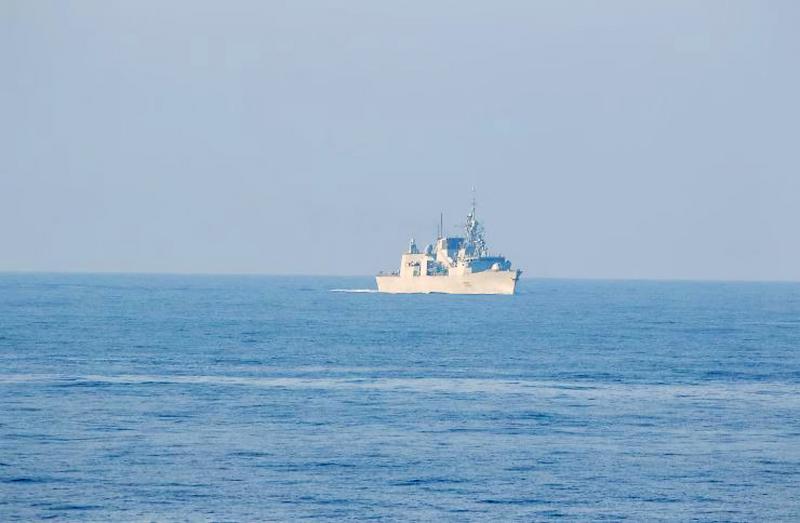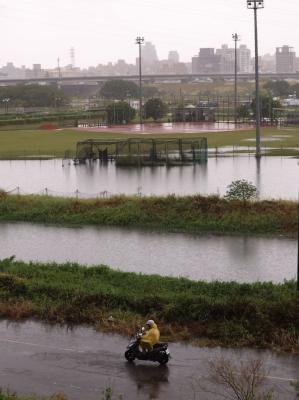China sailing a warship across the path of a US destroyer and Canadian frigate transiting the Taiwan Strait was an act of provocation, which also violated international sailing norms, Taiwan defense experts said yesterday.
The incident highlighted that China considers the Taiwan Strait a domestic waterway, and it was an attempt to demonstrate its military hegemony, they said.
They were referring to a Chinese vessel cutting in front of the USS Chung-Hoon, an Arleigh Burke-class guided-missile destroyer, as it conducted a joint mission with the HMCS Montreal in the Strait on Saturday.

Photo: Screen grab from US Navy 7th Fleet’s Web site
A video captured by Canadian network Global News onboard the Canadian frigate showed that the Chinese warship came within about 137m of the US destroyer.
Crew on the Canadian vessel contacted the Chung-Hoon after seeing the Chinese vessel alter its course and told the US ship to move to avoid a collision, Global News said.
The US destroyer responded by asking the Chinese warship to steer clear of the ship, but it ultimately needed to change course and decelerate, it said.
Captain Paul Mountford, commander of the HMCS Montreal, told the Vancouver-based broadcaster that it was “not professional” for the Chinese warship to cut in front of the Chung-Hoon, adding that the incident was “clearly instigated by the Chinese.”
“The fact this was announced over the radio prior to doing it clearly indicated this was intentional,” Mountford was quoted as saying.
Lu Li-shih (呂禮詩), a former lieutenant commander in the Taiwanese navy, yesterday wrote on Facebook that the Chinese guided-missile frigate had an obvious close encounter with the US destroyer, rather than an attempt to overtake it.
The 1972 International Regulations for Avoiding Collisions at Sea stipulate that the Chinese frigate should have yielded and avoided the US vessel, he said.
“Apparently, the actions of the 056A missile frigate were a clear warning to the US destroyer passing through the Taiwan Strait,” he added.
According to the regulations, if a ship spots another vessel approaching on a collision course from its starboard side, it should yield and avoid the vessel.
Should the situation permit it, the ship should avoid crossing the bow of the other ship, the regulations say.
In a paper published last year, titled “Exploring and Analyzing the Weaknesses of China’s Coastal Defense From the People’s Liberation Army’s (PLA) Summer Military Exercises,” Lu said that the Chinese military’s near-shore defense strategy has advanced from “strengthening near-shore air defense” in 2020 to “preventing enemy from breaking through at low altitude, deterring approaching reconnaissance.”
“Judging from the state of the CCP’s [Chinese Communist Party’s] exercises and real-time imagery intelligence, the PLA has extended significantly beyond its territorial waters, touching the sea and airspace under the US military’s air and sea ‘approaching reconnaissance,’” Lu said in the paper.
“This inference was first confirmed when China’s J-16 fighter intercepted the US military RC-135 military plane on May 26, and it was confirmed again when the Chinese warship crossed the bow of the US destroyer on Saturday,” Lu said yesterday.
Additional reporting by Chen Yu-fu

Taipei, New Taipei City, Keelung and Taoyuan would issue a decision at 8pm on whether to cancel work and school tomorrow due to forecasted heavy rain, Keelung Mayor Hsieh Kuo-liang (謝國樑) said today. Hsieh told reporters that absent some pressing reason, the four northern cities would announce the decision jointly at 8pm. Keelung is expected to receive between 300mm and 490mm of rain in the period from 2pm today through 2pm tomorrow, Central Weather Administration data showed. Keelung City Government regulations stipulate that school and work can be canceled if rain totals in mountainous or low-elevation areas are forecast to exceed 350mm in

EVA Airways president Sun Chia-ming (孫嘉明) and other senior executives yesterday bowed in apology over the death of a flight attendant, saying the company has begun improving its health-reporting, review and work coordination mechanisms. “We promise to handle this matter with the utmost responsibility to ensure safer and healthier working conditions for all EVA Air employees,” Sun said. The flight attendant, a woman surnamed Sun (孫), died on Friday last week of undisclosed causes shortly after returning from a work assignment in Milan, Italy, the airline said. Chinese-language media reported that the woman fell ill working on a Taipei-to-Milan flight on Sept. 22

COUNTERMEASURE: Taiwan was to implement controls for 47 tech products bound for South Africa after the latter downgraded and renamed Taipei’s ‘de facto’ offices The Ministry of Foreign Affairs is still reviewing a new agreement proposed by the South African government last month to regulate the status of reciprocal representative offices, Minister of Foreign Affairs Lin Chia-lung (林佳龍) said yesterday. Asked about the latest developments in a year-long controversy over Taiwan’s de facto representative office in South Africa, Lin during a legislative session said that the ministry was consulting with legal experts on the proposed new agreement. While the new proposal offers Taiwan greater flexibility, the ministry does not find it acceptable, Lin said without elaborating. The ministry is still open to resuming retaliatory measures against South

1.4nm WAFERS: While TSMC is gearing up to expand its overseas production, it would also continue to invest in Taiwan, company chairman and CEO C.C. Wei said Taiwan Semiconductor Manufacturing Co (TSMC) has applied for permission to construct a new plant in the Central Taiwan Science Park (中部科學園區), which it would use for the production of new high-speed wafers, the National Science and Technology Council said yesterday. The council, which supervises three major science parks in Taiwan, confirmed that the Central Taiwan Science Park Bureau had received an application on Friday from TSMC, the world’s largest contract chipmaker, to commence work on the new A14 fab. A14 technology, a 1.4 nanometer (nm) process, is designed to drive artificial intelligence transformation by enabling faster computing and greater power